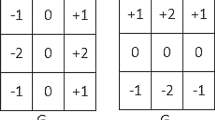Abstract
The discrimination of true and false edges in edge images is a challenging yet important problem that has not attracted the mainstream research community in image processing. Existing approaches often emphasize on detecting true edges while neglecting the handling of false edges. In addition, many existing techniques are complicated in nature, non-robust for handling different type of images, and suitable only for specific applications. In this paper, we proposed a technique that eliminates false edges from a binary edge image. We employed locally adaptive regression kernel (LARK) as descriptor of the detected edge. By using LARK, we identified false edges by comparing their descriptors with those from the reference flat region. All edges with descriptors similar to the reference flat region were labeled as false edges and eliminated. We tested our algorithm on edge images obtained from the widely used Canny edge detector and conducted qualitative and quantitative analysis on the proposed method. Extensive simulation results show that the proposed method successfully eliminates most false edges. Comparison between the proposed method with some famous edge detectors shows that our algorithm quantitatively outperforms others with an average Baddeley’s delta metric of 23.37.
















Similar content being viewed by others
References
Sharifi, M., Fathy, M., Mahmoudi, M.T.: A classified and comparative study of edge detection algorithms. In: Proceedings of the International Conference on Information Technology: Coding and Computing, IEEE, pp. 117–120 (2002)
Roberts, L.G.: Machine perception of three-dimensional solids. DTIC document (1963)
Sobel, I., Feldman, G.: A 3\(\times \)3 isotropic gradient operator for image processing. A talk at the Stanford artificial project, pp. 271–272 (1968)
Prewitt, J.M.: Object Enhancement and Extraction. Academic Press, New York (1970)
Canny, J.: A computational approach to edge detection. IEEE Trans. Pattern Anal. Mach. Intell. 8, 679–698 (1986)
Papari, G., Petkov, N.: Edge and line oriented contour detection: state of the art. Image Vis. Comput. 29, 79–103 (2011)
Martin, D.R., Fowlkes, C.C., Malik, J.: Learning to Detect Natural Image Boundaries Using Brightness and Texture, Advances in Neural Information Processing Systems, pp. 1255–1262, The MIT Press, Vancouver, Canada (2002)
Martin, D.R., Fowlkes, C.C., Malik, J.: Learning to detect natural image boundaries using local brightness, color, and texture cues. IEEE Trans. Pattern Anal. Mach. Intell. 26, 530–549 (2004)
Dollar, P., Tu, Z., Belongie, S.: Supervised learning of edges and object boundaries. In: IEEE Computer Society Conference on Computer Vision and Pattern Recognition, IEEE, pp. 1964–1971 (2006)
Tomasi, C., Manduchi, R.: Bilateral filtering for gray and color images. In: Sixth International Conference on Computer Vision, IEEE, pp. 839–846 (1998)
Farbman, Z., Fattal, R., Lischinski, D., Szeliski, R.: Edge-preserving decompositions for multi-scale tone and detail manipulation. ACM Trans. Gr. TOG 27(3), Art no. 67 (2008)
Xu, L., Lu, C., Xu, Y., Jia, J.: Image smoothing via L 0 gradient minimization. ACM Trans. Gr. TOG 30, 174 (2011)
Grigorescu, C., Petkov, N., Westenberg, M.A.: Contour detection based on nonclassical receptive field inhibition. IEEE Transl. Image Process. 12, 729–739 (2003)
Grigorescu, C., Petkov, N., Westenberg, M.A.: Contour and boundary detection improved by surround suppression of texture edges. Image Vis. Comput. 22, 609–622 (2004)
Azzopardi, G., Petkov, N.: A CORF computational model of a simple cell that relies on LGN input outperforms the Gabor function model. Biol. Cybern. 106, 177–189 (2012)
Sun, G., Liu, Q., Liu, Q., Ji, C., Li, X.: A novel approach for edge detection based on the theory of universal gravity. Pattern Recognit. 40, 2766–2775 (2007)
Medina-Carnicer, R., Madrid-Cuevas, F.J., Carmona-Poyato, A., Muñoz-Salinas, R.: On candidates selection for hysteresis thresholds in edge detection. Pattern Recognit. 42, 1284–1296 (2009)
Takeda, H., Farsiu, S., Milanfar, P.: Kernel regression for image processing and reconstruction. IEEE Trans. Image Process. 16, 349–366 (2007)
Seo, H.J., Milanfar, P.: Static and space-time visual saliency detection by self-resemblance. J.Vis. 9, 1–27 (2009)
Seo, H.J., Milanfar, P.: Visual saliency for automatic target detection, boundary detection, and image quality assessment. In: IEEE International Conference on Acoustics Speech and Signal Processing (ICASSP), IEEE, pp. 5578–5581 (2010)
Seo, H.J., Milanfar, P.: Training-free, generic object detection using locally adaptive regression kernels. IEEE Trans. Pattern Anal. Mach. Intell. 32, 1688–1704 (2010)
Seo, H.J., Milanfar, P.: Action recognition from one example. IEEE Trans. Pattern Anal.Mach. Intell. 33, 867–882 (2011)
Seo, H.J., Milanfar, P.: Face verification using the lark representation. IEEE Trans. Inf. Forensics Secur. 6, 1275–1286 (2011)
Martin, D.R., Fowlkes, C.C., Tal, D., Malik, J.: A database of human segmented natural images and its application to evaluating segmentation algorithms and measuring ecological statistics. In: Proceedings of the Eighth IEEE International Conference on Computer Vision, ICCV 2001. IEEE, pp. 416–423 (2001)
Lopez-Molina, C., De Baets, B., Bustince, H.: Quantitative error measures for edge detection. Pattern Recognit. 46(4), 1125–1139 (2013)
Olson, D.L., Delen, D.: Advanced Data Mining Techniques. Springer, Berlin (2008)
Lopez-Molina, C., De Baets, B., Bustince, H., Sanz, J., Barrenechea, E.: Multiscale edge detection based on Gaussian smoothing and edge tracking. Knowledge-Based Syst. 44, 101–111 (2013)
Baddeley, A.J.: An error metric for binary images. In: Forstner, W., Ruwiedel, S. (eds.) Robust Computer Vision: Quality of Vision Algorithms, pp. 59–78. Wichmann Verlag, Karlsruhe (1992)
Baddeley, A.J.: Errors in binary images and an Lp version of the Hausdorff metric. Nieuw Archief voor Wiskunde 10, 157–183 (1992)
Lopez-Molina, C., Bustince, H., Fernández, J., Couto, P., De Baets, B.: A gravitational approach to edge detection based on triangular norms. Pattern Recognit. 43, 3730–3741 (2010)
Lopez-Molina, C., De Baets, B., Bustince, H.: Generating fuzzy edge images from gradient magnitudes. Comput. Vis. Image Underst. 115, 1571–1580 (2011)
Author information
Authors and Affiliations
Corresponding author
Rights and permissions
About this article
Cite this article
Abu Samah, H., Mat Isa, N.A. & Toh, K.K.V. Automatic false edge elimination using locally adaptive regression kernel. SIViP 9, 1339–1351 (2015). https://doi.org/10.1007/s11760-013-0579-2
Received:
Revised:
Accepted:
Published:
Issue Date:
DOI: https://doi.org/10.1007/s11760-013-0579-2




